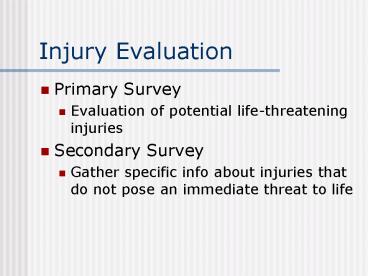Injury Evaluation PowerPoint PPT Presentation
1 / 18
Title: Injury Evaluation
1
Injury Evaluation
- Primary Survey
- Evaluation of potential life-threatening injuries
- Secondary Survey
- Gather specific info about injuries that do not
pose an immediate threat to life
2
Primary Survey
- Initial on the field assessment
- Airway, Breathing, Circulation
- Determines the existence of limb/life-threatening
situation - Time is of the essence
- Provides direction of emergency care
3
Secondary Survey
- Only after r/o life-threatening injuries
- Athlete is conscious
- Includes
- Vital signs
- History
- Musculoskeletal evaluation
- Treatment plan
- Transport
- Details to follow on 10-08-04!
4
Evaluation for Unconscious Athlete Step 1
- Must always assume head/neck injury until proven
otherwise!!! - Protect athlete from unnecessary movement
- Note body position
- Did you observe MOI??
- LOC
- Airway
- Breathing
- Circulation
5
?????
- How would you establish the athletes..
- responsiveness (LOC)???
- airway???
- breathing???
- circulation???
6
Youre on the clock
- If no breathing, no pulse.
- 0-4 minutesbrain damage unlikely
- 4-6 minutesbrain damage possible
- 6-10 minutesbrain damage likely
7
Step 2
- Do NOT remove helmet or shoulder pads
- Strings and straps should be cut
- Remove face mask regardless of current
respiratory status - Battery-powered screw driver, FM Extractor,
Trainers Angels, ect - NATA position statement guidelines
8
????
- What would you do if you did not have the correct
equipment to remove the face mask???
9
Step 3
- If supine and breathing-
- MONITOR
- If supine and not breathing-
- BEGIN RESCUE BREATHING
- If supine, not breathing and no pulse-
- BEGIN CPR
10
Step 4
- If prone and breathing-
- MONITOR UNTIL ATHLETE REGAINS CONSCIOUSNESS
- Athlete should then be log-rolled onto spine
board in order to perform CPR if necessary
11
??????
- How would you determine if a prone athlete is
breathing????
12
Step 5
- If prone and not breathing-
- LOGROLLED TO SUPINE, BEGIN RESCUE BREATHING
- If prone, not breathing, and no pulse-
- LOGROLLED, BEGIN CPR
13
Step 6
- Provide life support until EMS arrives
- Except if fatigued, situation becomes dangerous,
or begin breathing on own
14
?????
- How would you provide Rescue Breathing/CPR to an
athlete with a suspected C-spine injury????
15
Your Legal Protection
- Purchase liability insurance
- Good Samaritan Law
- Provides limited protection against legal action
to a person who volunteers to provide reasonable
care consistent with their level of training,
should something go wrong - Covers you outside the realm of your liability
insurance
16
Take home points
- Only move unconscious athlete if NO ABCs
- If unconscious and established ABCs, leave in
original position and monitor - Call EMS as soon as ABCs are compromised
- Always assume C-spine injury
17
Review for Todays Lab
- CPR
- Rescue Breathing
- Heimlich Maneuver
- CPR, Rescue Breathing, and C-spine immobilization
for a victim in the water
18
Things you should know
- Define cyanotic.
- What is the recovery position?
- Define ataxia.
- Define apnea.
- Define hypoxia.

